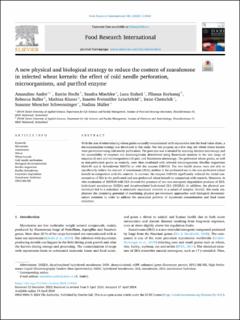Please use this identifier to cite or link to this item:
https://doi.org/10.21256/zhaw-30591| Publication type: | Article in scientific journal |
| Type of review: | Peer review (publication) |
| Title: | A new physical and biological strategy to reduce the content of zearalenone in infected wheat kernels : the effect of cold needle perforation, microorganisms, and purified enzyme |
| Authors: | André, Amandine Hecht, Katrin Mischler, Sandra Stäheli, Luca Kerhanaj, Fllanza Buller, Rebecca Kinner, Mathias Freimüller Leischtfeld, Susette Chetschik, Irene Miescher Schwenninger, Susanne Müller, Nadina |
| et. al: | No |
| DOI: | 10.1016/j.foodres.2024.114364 10.21256/zhaw-30591 |
| Published in: | Food Research International |
| Volume(Issue): | 186 |
| Issue: | 114364 |
| Issue Date: | 19-Apr-2024 |
| Publisher / Ed. Institution: | Elsevier |
| ISSN: | 0963-9969 1873-7145 |
| Language: | English |
| Subjects: | Mycotoxins; Zearalenone; wheat; Wheat kernels; cold needle perforation; Biological decontamination; bacillus megaterium; Bacillus licheniformis; Enzymatic degradation; Zearalenone hydrolase; HPLC-MS/MS |
| Subject (DDC): | 664: Food technology |
| Abstract: | With the aim of reintroducing wheat grains naturally contaminated with mycotoxins into the food value chain, a decontamination strategy was developed in this study. For this purpose, in a first step, the whole wheat kernels were pre-treated using cold needle perforation. The pore size was evaluated by scanning electron microscopy and the accessibility of enzymes and microorganisms determined using fluorescent markers in the size range of enzymes (5 nm) and microorganisms (10 μm), and fluorescent microscopy. The perforated wheat grains, as well as non-perforated grains as controls, were then incubated with selected microorganisms (Bacillus megaterium Myk145 and B. licheniformis MA572) or with the enzyme ZHD518. The two bacilli strains were not able to significantly reduce the amount of zearalenone (ZEA), neither in the perforated nor in the non-perforated wheat kernels in comparison with the controls. In contrast, the enzyme ZHD518 significantly reduced the initial concentration of ZEA in the perforated and non-perforated wheat kernels in comparison with controls. Moreover, in vitro incubation of ZHD518 with ZEA showed the presence of two non-estrogenic degradation products of ZEA: hydrolysed zearalenone (HZEA) and decarboxylated hydrolysed ZEA (DHZEA). In addition, the physical pre-treatment led to a reduction in detectable mycotoxin contents in a subset of samples. Overall, this study emphasizes the promising potential of combining physical pre-treatment approaches with biological decontamination solutions in order to address the associated problem of mycotoxin contamination and food waste reduction. |
| URI: | https://digitalcollection.zhaw.ch/handle/11475/30591 |
| Fulltext version: | Published version |
| License (according to publishing contract): | CC BY 4.0: Attribution 4.0 International |
| Departement: | Life Sciences and Facility Management |
| Organisational Unit: | Institute of Chemistry and Biotechnology (ICBT) Institute of Food and Beverage Innovation (ILGI) |
| Published as part of the ZHAW project: | Strategien zur Reduktion von Mykotoxinen in Getreidenebenproduktströmen |
| Appears in collections: | Publikationen Life Sciences und Facility Management |
Files in This Item:
| File | Description | Size | Format | |
|---|---|---|---|---|
| 2024_Andre-etal_Reduction-of-zearalenone-content-in-infected-wheat-kernels.pdf | 3.26 MB | Adobe PDF |  View/Open |
Show full item record
André, A., Hecht, K., Mischler, S., Stäheli, L., Kerhanaj, F., Buller, R., Kinner, M., Freimüller Leischtfeld, S., Chetschik, I., Miescher Schwenninger, S., & Müller, N. (2024). A new physical and biological strategy to reduce the content of zearalenone in infected wheat kernels : the effect of cold needle perforation, microorganisms, and purified enzyme. Food Research International, 186(114364). https://doi.org/10.1016/j.foodres.2024.114364
André, A. et al. (2024) ‘A new physical and biological strategy to reduce the content of zearalenone in infected wheat kernels : the effect of cold needle perforation, microorganisms, and purified enzyme’, Food Research International, 186(114364). Available at: https://doi.org/10.1016/j.foodres.2024.114364.
A. André et al., “A new physical and biological strategy to reduce the content of zearalenone in infected wheat kernels : the effect of cold needle perforation, microorganisms, and purified enzyme,” Food Research International, vol. 186, no. 114364, Apr. 2024, doi: 10.1016/j.foodres.2024.114364.
ANDRÉ, Amandine, Katrin HECHT, Sandra MISCHLER, Luca STÄHELI, Fllanza KERHANAJ, Rebecca BULLER, Mathias KINNER, Susette FREIMÜLLER LEISCHTFELD, Irene CHETSCHIK, Susanne MIESCHER SCHWENNINGER und Nadina MÜLLER, 2024. A new physical and biological strategy to reduce the content of zearalenone in infected wheat kernels : the effect of cold needle perforation, microorganisms, and purified enzyme. Food Research International. 19 April 2024. Bd. 186, Nr. 114364. DOI 10.1016/j.foodres.2024.114364
André, Amandine, Katrin Hecht, Sandra Mischler, Luca Stäheli, Fllanza Kerhanaj, Rebecca Buller, Mathias Kinner, et al. 2024. “A New Physical and Biological Strategy to Reduce the Content of Zearalenone in Infected Wheat Kernels : The Effect of Cold Needle Perforation, Microorganisms, and Purified Enzyme.” Food Research International 186 (114364). https://doi.org/10.1016/j.foodres.2024.114364.
André, Amandine, et al. “A New Physical and Biological Strategy to Reduce the Content of Zearalenone in Infected Wheat Kernels : The Effect of Cold Needle Perforation, Microorganisms, and Purified Enzyme.” Food Research International, vol. 186, no. 114364, Apr. 2024, https://doi.org/10.1016/j.foodres.2024.114364.
Items in DSpace are protected by copyright, with all rights reserved, unless otherwise indicated.